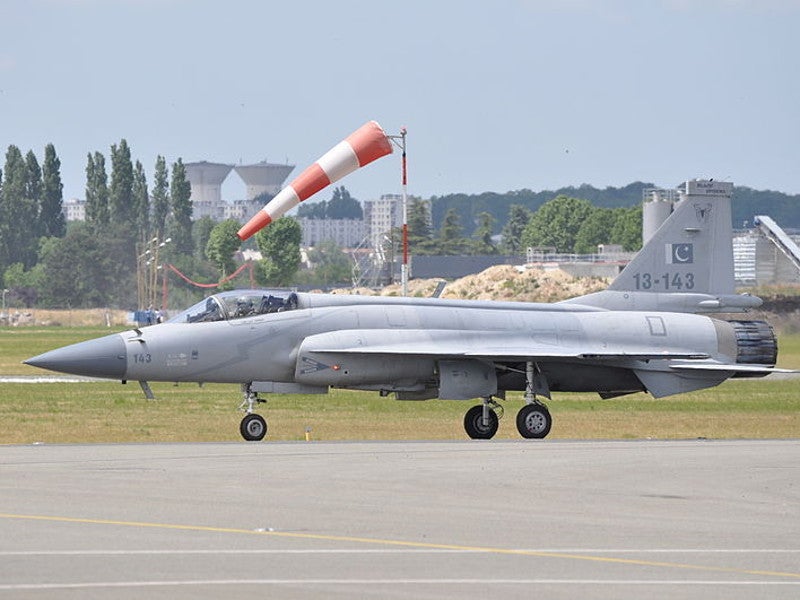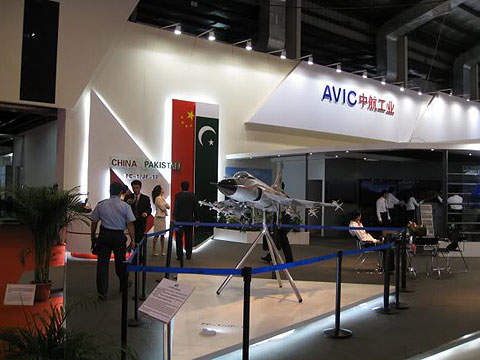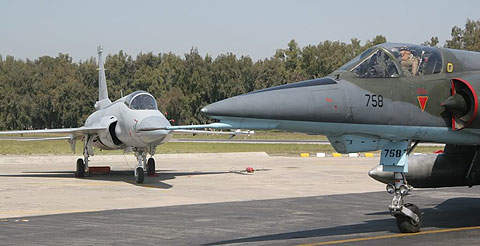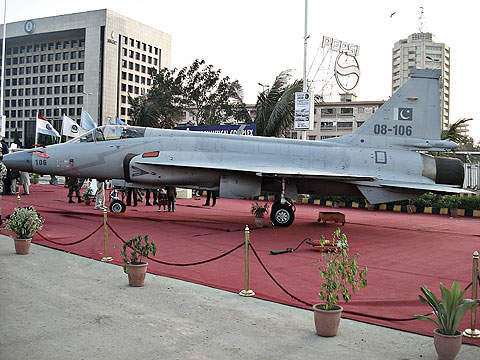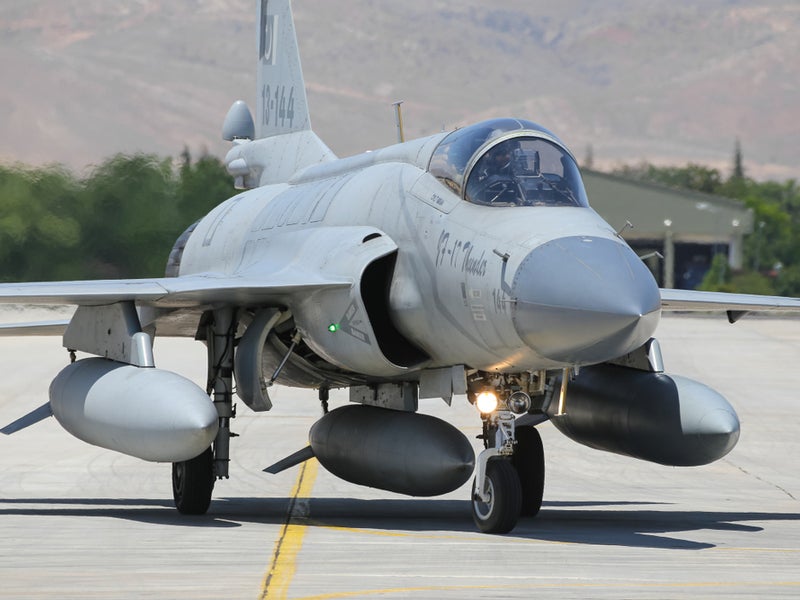JF-17 Thunder/FC-1 Xiaolong is a single-engine, lightweight, multipurpose combat aircraft that was developed jointly by Chengdu Aircraft Industry Corporation (CAC) of China and Pakistan Aeronautical Complex (PAC) of Pakistan.
The medium-sized aircraft is built mainly to meet the needs of the Pakistan Air Force (PAF) and will replace its current ageing fleet of Nanchang A-5, Chengdu F-7P / PG and Dassault Mirage III / V fighter aircraft.
JF-17’s maiden flight was completed in August 2003 and entered service in March 2007. The aircraft is designated as Joint Fighter-17 (JF-17 by Pakistan and as Fighter China-1 (FC-1) by China. The JF-17 / FC-1 is expected to cost $15m-20m.
The No.26 Squadron Black Spiders is the first JF-17 Squadron of the PAF, introduced in February 2010. It has been launched with 14 JF-17 aircraft.
JF-17 was showcased at the Farnborough Air Show 2010. Two aircraft of the No.26 Black Spiders Squadron were also displayed at the show.
JF-17 Thunder orders and deliveries
PAF ordered eight JF-17 aircraft. The first two were delivered on 12 March 2007 and the remaining six were delivered in 2008.
PAF will procure 42 JF-17 fighters as part of an $800m contract signed in March 2009. It plans to procure 250 aircraft at a cost of $3bn-5bn.
The first two aircraft were delivered in 2009. The first Pakistani-built JF-17 was delivered to PAF in November 2009, while the 50th aircraft was delivered to the Pakistan Air Force in 2013.
The Myanmar Air Force (MAF) placed a contract for 16 JF-17/FC-1 aircraft in December 2015. The fighter was inducted into service in December 2018.
FC-1 design
China signed an agreement with Pakistan in May 2011 to supply 50 additional JF-17 thunder jets to replace the ageing MiG-21 and Northrop F-5 Tiger fighter aircraft.
Chengdu Aircraft Design Institute designed the FC-1. The airframe is a semi-monocoque structure and is constructed principally of aluminium alloys, steel and titanium. The aircraft comprises lateral air intakes and electronic equipment pod diffuser supersonic inlets.
JF-17 Thunder development
Development of the JF-17 began with the origination of Super-7 in 1986 under a $500m joint Chengdu-Grumman development project, but the project was cancelled for financial and political reasons.
Chengdu continued the development of Super-7 in 1991 under the Fighter China project. Pakistan and China signed a memorandum of understanding (MoU) in 1995 to build the aircraft. In 1998, the countries signed a letter of intent and the contract was awarded in June 1999.
To speed up development, the avionics and radar systems design of the aircraft was separated from the airframes. The preliminary design was completed in 2001 and the detailed structure in 2002. Funding for the programme was provided by China Aviation Import and Export Corporation (CATIC) and Pakistan, each owning a 50% stake.
Development of the first prototype began in September 2002 and production was completed in May 2003. Design flaws of the JF-17 were identified after its first flight in 2003. After a significant redesign, the fourth prototype production was completed in April 2006. The sixth prototype first flew in September 2006.
Sub-assemblies of the JF-17 started in Pakistan on 22 January 2008 and final assembly began in June 2009.
Development of JF-17B, a two-seat combat / trainer version of the JF-17, was announced in February 2012.
PAC started the production of upgraded JF-17 Block II version in December 2013.
The dual seat version, JF-17B, made its first flight in April 2017. The first aircraft was unveiled by PAC in December 2019.
The first JF-17 Block III prototype completed its maiden flight in January 2020.
JF-17 cockpit
JF-17 is equipped with a glass cockpit and a specially designed canopy. The cockpit features three multifunction displays (MFD), head-up display (HUD), 32-bit weapon and mission management computer (WMMC), and a hands-on throttle and stick.
An up-front control panel (UFCP) is fitted between the MFD and HUD. The Chinese HUD is designed and developed to overwhelm the fog-up error that frequently occurs in humid, sub-tropical and tropical zones.
An acrylic canopy covers the aircraft’s cockpit and provides clear all-round visibility.
Avionics
The avionics suite includes an electronic flight instrumentation system (EFIS), flight control system (FCS), health and usage monitoring system (HUMS), automatic test equipment, UHF / VHF communication radios, simpatico data links, inertial navigation system (INS) and an identification friend-or-foe (IFF) transponder.
Armament aboard JF-17
JF-17 / FC-1 is armed with GSh-23 dual-barrel 23mm cannon or GSh-30 dual-30mm cannon. The aircraft has seven hardpoints, with four located under the wings, one under the fuselage, and two mounted on the wingtips. It can carry up to 3,700kg payload.
The aircraft is fitted with PL-12 or SD-10 radar homing medium-range air-to-air missile (MRAAM), unguided bombs, satellite guided bombs, gravity bombs, anti-ship missiles, anti-radiation missiles, rocket launchers and a laser designator pod.
JF-17 / FC-1 is equipped with AIM-9L / M, PL-5E, PL-9C short range air-to-air missiles on its wingtip hardpoints.
Countermeasures
JF-17 / FC-1 is equipped with a defensive aids system (DAS), which includes a radar warning system (RWS), missile approach and warning system (MAWS), a countermeasure dispensing system, and a self-protection radar jamming pod. The RWS collects the direction and proximity of the enemy radar and transmits the data to the pilot.
The MAWS comprises various optical sensors that detect and display the rocket missiles approaching the aircraft on MFDs. The decoy flares and chaff incorporated in the countermeasure dispensing system prevents the enemy’s missile from tracking the aircraft by locking the radar system of the enemy aircraft.
JF-17 radars
The initial 42 JF-17 aircraft being delivered to PAF are fitted with an NRIET KLJ-7 radar. The KLJ-7 radar can track ten targets located beyond visual range (BVR) through track-while-scan mode.
An Italian Galileo Avionica Grifo S-7 pulse Doppler radar will replace the KLJ-7 radar in PAF’s JF-17 aircraft. This radar can operate in 25 working modes for 200 hours continuously. Look-down, shoot-down and ground-strike are further capabilities.
Landing gear
A retractable tricycle-type landing gear is fitted to the JF-17. A steerable nose wheel is located under the cockpit between the air intakes, while the two main wheels are attached under the fuselage section between the wings. It also features hydraulic brakes comprising an automated anti-skid system.
The JF-17 / FC-1 is powered by a single Klimov RD-93 turbofan engine. Each engine can produce a maximum of 49.4kN dry thrust and its thrust after-burner is 84.4kN.
An advanced WS-13 turbofan engine is currently being developed by Liyang Aero Engine Corporation, Guizhou, to replace the Klimov RD-93. It is expected to produce an output thrust of 80kN to 86.36kN with a lifespan of 2,200 hours.
The fuel system, featuring internal fuel tanks carrying 2,330kg of fuel, is fitted to the FC-1. These tanks can be refuelled through a single-point-of-pressure refuelling system. The fuel system is also simpatico with Inflight Refuelling (IFR). The JF-17 being produced for the PAF will be fitted with IFR probes.
JF-17 performance
The JF-17 Thunder/ FC-1 can fly at a maximum speed of 1,909km/h. The range and service ceiling of the aircraft are 2,037km and 15,240m, respectively. Its operational radius is 1,352km. The aircraft weighs around 6,411kg and its maximum take-off weight is 12,474kg.

